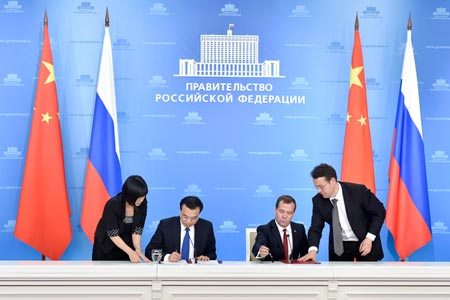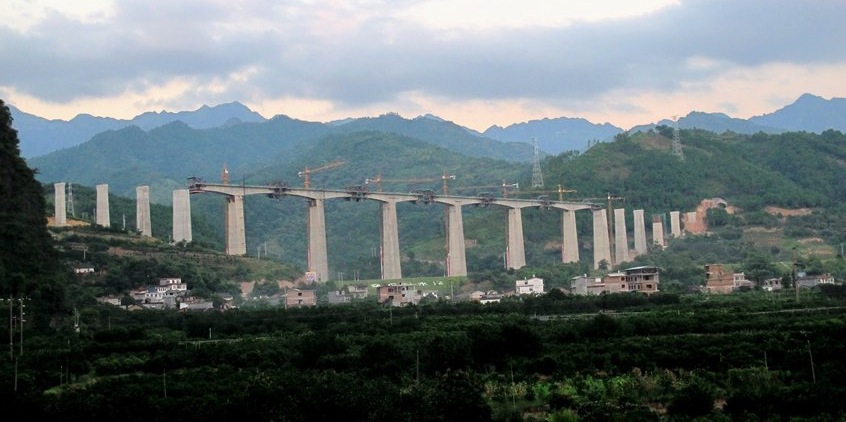The global reach of China’s high-speed rail industry extended even further this week when it was announced that a conglomerate led by China Railway Construction Corporation (CRCC) was the only candidate for a high-speed line in Mexico, and that it was to begin work on a vast 7,000km network that would integrate the economies of central Asia with Beijing and Moscow. At the same time, the Chinese domestic market, which already has the biggest national network in the world, is set for a 64% expansion.
The Ministry of Communications and Transport announced on Wednesday that CRCC was the only bidder for the line, which will run 210km north-west from Mexico City to the growing industrial centre of Querétaro. However, it added that the tendering process would start again if CRCC’s entry was not satisfactory.
The Mexican government is planning to move 23,000 daily commuters at a cost of just over $20 each to and from Querétaro at speeds of up to 300kph. The cost of the line has been estimated at $3bn, and it is the first stage in a $100bn plan to renew Mexico’s road, rail, sea port and telecoms infrastructure.Â
Rail is a particular focus because the country’s state-owned intercity passenger system dwindled away after privatisation in the 1990s. The government of President Enrique Peña Nieto plans to revive the service by building a $25bn high-speed network that that will radiate from Mexico City to Querétaro and Guadalajara in the west, Monterrey in the north-east and Veracruz and Acapulco in the south.Â
The prize for CRCC is potentially huge: if it is chosen to build the line, and does so successfully, it will have established the local knowledge and contacts to win more of Mexico’s high-speed passenger rail network.Â
Who might challenge the Chinese? Executives from Canada’s Bombardier and German engineer Siemens had expressed an interest in taking part in Mexico’s rail programme, and Mexican billionaire Carlos Slim had said he was considering investing but, so far, no other railway builder appears to be in the frame.Â
Russian-Chinese railway deal
The announcement in Mexico followed a deal reached on Monday during a meeting in Moscow between Chinese prime minister Li Keqiang and Russian president Vladimir Putin. Under the agreement, China will help to construct Russia’s first high-speed, a 770km link that will run between Moscow and Kazan, the capital of the Russian republic of Tartarstan. When complete, the line would reduce the travel time between Moscow and Kazan from 11.5 hours to 3.5.
As with the Mexican scheme, it would be the first phase of a much bigger programme, in this case a 7,000km network that would link the main urban and industrial areas of central Asia with Moscow and Beijing.
The $25bn deal was signed between Russian Railways and the China’s National Development and Reform Commission. China will invest around $10bn of the capital. According to Vladimir Yakunin, the president of Russian Railways, design work on the railway may begin later this year.

1)The signing ceremony that will begin a 7,000 rail network to integrate the economies of central Asia (Xinhua News Agency)
As well as the rail deal, the two leaders agreed to work together on other transport and energy schemes, including the development of heavy helicopters and a very large aircraft to rival Airbus’s A380, the exploration of two natural gas fields, more pipelines, nuclear power plants and the expansion of Russia’s Zarubino port on the Pacific coast, south of Vladivostok.Â
The new silk ‘road’
Even more ambitious, politically and symbolically, is a proposed 6,000km high-speed route from its western borders that would follow the ancient silk route through central Asia before turning south into Iran and running west through Turkey and Bulgaria to western Europe.
Chinese media have been enthusing over the scale of the “Silk Road Economic Belt” concept. It would involve more than 40 Asian and European countries and would knit together regions with a combined population of 3 billion. As well as restoring the glory of an ancient trade network that affirmed the prestige of the Middle Kingdom, it would have a very practical use – China could ship its manufactured goods to the West in 15-20 days, rather than the 35-45 it presently takes by sea.
Chinese president Xi Jinping first floated the idea last year, but momentum began to build in July, when China invited nearly 100 representatives from 11 countries to Beijing to probe the possibilities.
Chinese media reported one expert who said the line would cost $150bn and be complete by 2030, but that a host of factors, including geopolitics and the need to get all countries to agree to use the standard gauge, would present challenges.
Some links in the route are already under way. In July, an Iranian-Chinese consortium was awarded a contract to build a 400km high-speed line between Tehran and the north-eastern city of Mashhad near the border with Afghanistan. And others have already been built, most notably the Ankara to Istanbul link, completed in July by CRCC and China National Machinery Import and Export Corporation, with help from Turkish firms Cengiz Construction and Ibrahim Cecen Ictas Construction.Â
The trans-African lineÂ
Alongside these schemes, China is about to lay track for a shorter and faster version of the Cape-to-Cairo rail line that imperialist planners such as Cecil Rhodes proposed as a way of uniting Britain’s colonial possessions. China’s version will begin with a line that runs from Ethiopia and South Sudan to the Great Lake states in the south.
Ultimately this may be united with the 1,344km Benguela railway linking Angola’s Atlantic port of Lobito to the eastern border town of Luau, which CRCC completed in August, at a cost of $1.8bn. If the two systems are joined, they will provide the means of opening up the vast, and largely untapped, mineral resources of the Congo Basin, which will be needed to keep China’s economy growing at its present rate of 7%.Â
The “Snowpiercer” line
Other rail schemes China has put forward have been more speculative, such as the line across the Brazilian Amazon and the Andes, mooted in July. Some have verged on the fantastical, such as the railway to America. Put forward in May, the idea is to lay track across Siberia to a 200km tunnel under the Bering Straits to Alaska, then south through Canada to the US, bringing to mind the transglobal rail line put forward in the science fiction film Snowpiercer.
This idea came not from government but from a rail expert called Wang Mengshu, of the Chinese Academy of Engineering, in an interview with the Beijing Times. It was then seized upon by China’s outward-facing media. “In not so distant future, people can take the train from China to the US,” wrote the European edition of the state-run China Daily.
Whatever its chances of being built, the railway to America notion gave Chinese commentators the chance to propose what it meant for China to be the world’s builder of railways, and they lost no time contrasting the 19th and 20th-century gunboat to the 21st-century Chinese locomotive: Chinese rail is a force for good, they said.

1)When Chinese rail layers meet difficult terrain, they tend to lift the track off the ground – as here at the Xingping reservoir (Billyshanenunn/Wikimedia Commons)
“The West built today’s world order using warships at sea,” wrote Li Yang in China Daily. “China, India and other emerging Asian countries will make changes to the world order by building a more integrated land transportation system … The colonial powers’ maritime war and transportation system benefited themselves, and the world order built on that system is not fair for the developing and least developed countries. But the high-speed railway system, which will be built by different countries working together, can help make the modern world order fairer for the international community as a whole.”Â
Expanding at home
It doesn’t capture international attention so much anymore but, at home, China presses on with a staggering expansion of its rail network. The number of electric locomotives in the country has increased from 7,695 in 2013 to more than 10,500 and, this week, the country’s top economic planner announced approvals for new projects totalling $11.4bn.Â
Earlier this year, the Chinese Railway Authority announced that it was to expand its present network, which is somewhere north of 11,000km, by almost 7,000km. This comprises 48 projects and investments in rail in the first quarter of this year increased by 9% compared with the first quarter of 2013.
China’s domestic rail programme has had its difficulties. In 2011, two high-speed trains collided on a viaduct in Wenzhou, killing 40 people and injuring 192 others. Two years later the government disbanded the entire Ministry of Railways, which had come under fire for corruption and inefficiency.Â
Just this morning, the rail ministry’s former deputy chief engineer, Zhang Shuguang, was handed a suspended death sentence after being found guilty by a Beijing court of taking bribes worth $7.7m over 11 years.Â
Questions have also been raised over the enormous debts incurred by the contractors building the network. On the other hand, the wider rail industry has soared on news of the latest plans. Shares in Beijing-based train maker CSR Corporation, which makes the iconic CRH380 locomotive, jumped 10% in Shanghai on Wednesday, the maximum allowed by stock exchange rules. China CNR Corporation, another maker of rolling stock, rose 9.9%. CRCC was up 6.7%. All these companies are state-owned enterprises with some publicly traded stock.Â
Global vision
It used to be that China built railways in poor African countries to access precious natural resources: with its vast capital reserves, its appetite for risk, and its armies of willing workers, China was willing to invest and build where no other country would.
Now its strategy is broader and more sophisticated. In 2009 China articulated its vision for a global strategic network of three high speed rail lines spanning Eurasia, Central Asia and the rest of Asia. We haven’t yet mentioned China’s plans to build to connect its system with the rest of south-east Asia.Â
Wherever rail development is on the table, China is there, even in developed economies including the UK and Saudi Arabia.
For China, rail is a way of sponsoring its companies and technologies internationally, providing jobs for its people, investing in potentially lucrative developments, boosting its diplomatic influence and getting its goods to market.Â
Whether or not Chinese railways will physically encircle the world, it’s hard to think of another example (America with the Internet? Britain or France in the Age of Sail?) of a single country using a single medium with such skill and determination.
Comments
Comments are closed.







World class construction – covering the planet! I guess with the Chinese space program there are visionary planers in that nation contemplating high speed criss-crossing the mining sites on the moon. Sounds like a fantastic non-fiction future to me (once we perfect a FUSION ENERGY economy detected to the common interests of mankind) – lets not ‘shoot’ for it but set our creative thoughts in that blossoming paradigm.